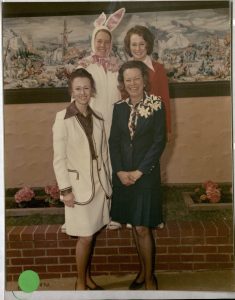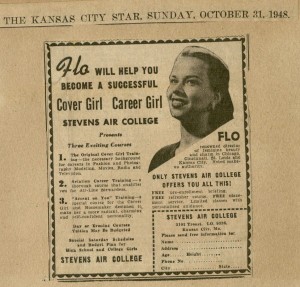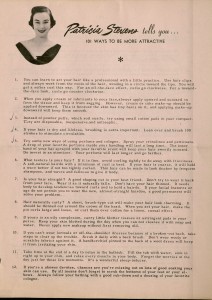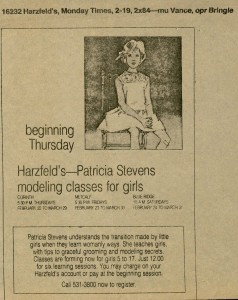The recent passing of Melissa Stevens, heir to the Patricia Stevens Modeling School and Career College, has given us cause to take a look through one of the most extraordinary collections in LaBudde’s holdings: the Patricia Stevens Collection. This collection, which Melissa donated in November 2011, contains the company records, advertisements, photographs, and other ephemera. There are hundreds of items in over fifty boxes and together they offer a complete account of the history of the company.

1973 photo of Flo Stevens (bottom right) and her three daughters (clockwise from bottom left) Patricia Jr, Sheila, and Melissa.
Melissa’s mother, Florence Czarnecki Stevens became “Patricia Stevens” only after her 1946 marriage to a young Chicago entrepreneur named James Stevens. Before he met Flo, he had already named his training school, a business designed to help women navigate the postwar work world. Flo – or Mrs. Stevens as she was often addressed – grew the school into a franchised operation with 55 branches. Its headquarters were in Kansas City, on Country Club Plaza. (Longtime KC residents may recall the Stevens-sponsored annual Easter parade that ran up until 1995). A full account of the Stevens’ family and their company could occupy an entire book. Melissa Stevens took over the company after her mother’s death, and up until her own recent passing was working to revive the company. In a 2012 interview with The Pitch, she said “All I really need…is a runway, a makeup table, a mirror — and me.”
[ngg_images source=”galleries” container_ids=”4″ sortorder=”16,14,15″ display_type=”photocrati-nextgen_basic_imagebrowser” ajax_pagination=”1″ order_by=”sortorder” order_direction=”ASC” returns=”included” maximum_entity_count=”500″]
One of the items Melissa Stevens donated was a large scrapbook filled with letters of appreciation written to her mother Flo. Among the letters are many from former students and employees. Flo Stevens appears to have had a special relationship with many of her graduates and employees. One student said that Flo was “the woman who changed my life.” Another wished “I could explain how much I think of you. You have been like a big sister to me and you have my deepest respect.” Still another told Flo that “my heart had adopted you as a second mother.” Other students wrote about how the Stevens school could help them with self-esteem issues or help them conquer their fears. Some of her graduates went on to pursue careers in acting or fashion, or interior design. Reading their letters, they all give some credit to Florence Stevens for their success.
The most poignant letter in the collection is from one of Stevens’ employees. She [find her name] writes to Flo about a 14 year old girl – Marilyn – who wanted to be a model and was attending classes against her parents’ wishes. Her parents believed that any kind of modeling would “lower [Marilyn’s] morals” and corrupt her. The letter explains that Marilyn might not be destined for a modeling career, but that she at least deserved the chance to follow her dreams, even if she was still young.
[ngg_images source=”galleries” container_ids=”5″ sortorder=”22,21,23,24″ display_type=”photocrati-nextgen_basic_imagebrowser” ajax_pagination=”1″ order_by=”sortorder” order_direction=”ASC” returns=”included” maximum_entity_count=”500″]
There is, I think, a contradiction buried at the heart of the Stevens collection. On one hand, the modeling school may seem anachronistic by today’s standards. Expectations for women were undoubtedly different in the 1960s and 70s than they are now. On the other hand, based on these letters Stevens’ modeling, etiquette and career-related courses do seem to have changed young women’s lives for the better. Women in the 1960s and 70s were starting to make social gains that still haven’t been fully realized. The Stevens school embodies both of those: recognizing that even though women were still expected to behave in certain ways, there were also new opportunities opening up for them, and they would need appropriate education and training in order to succeed. In short, Stevens tried to provide both of those. Perhaps then there is more to the modeling school than meets the eye. Projecting our modern ideas backwards even a couple generations isn’t always wise. As antiquated, unhealthy, and even incorrect as instruction about posture, diet, personal care and etiquette may have been, it’s clear at least some of Stevens’ students found what they learned empowering and that they credited her with helping them improve their lives.



